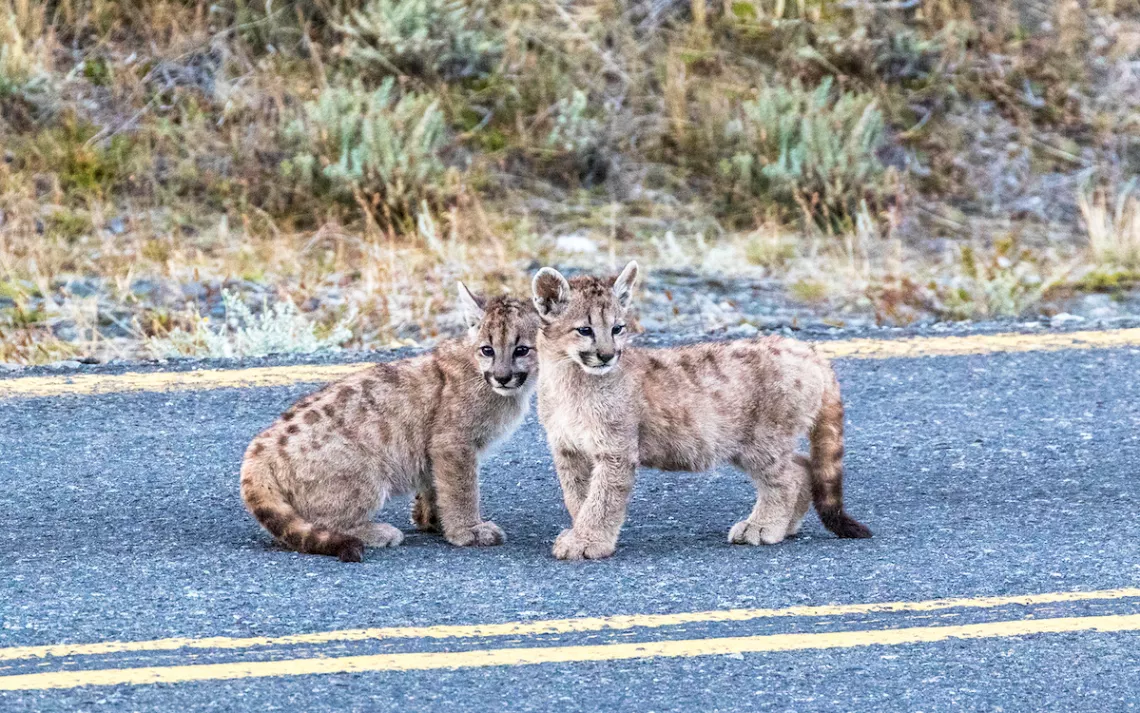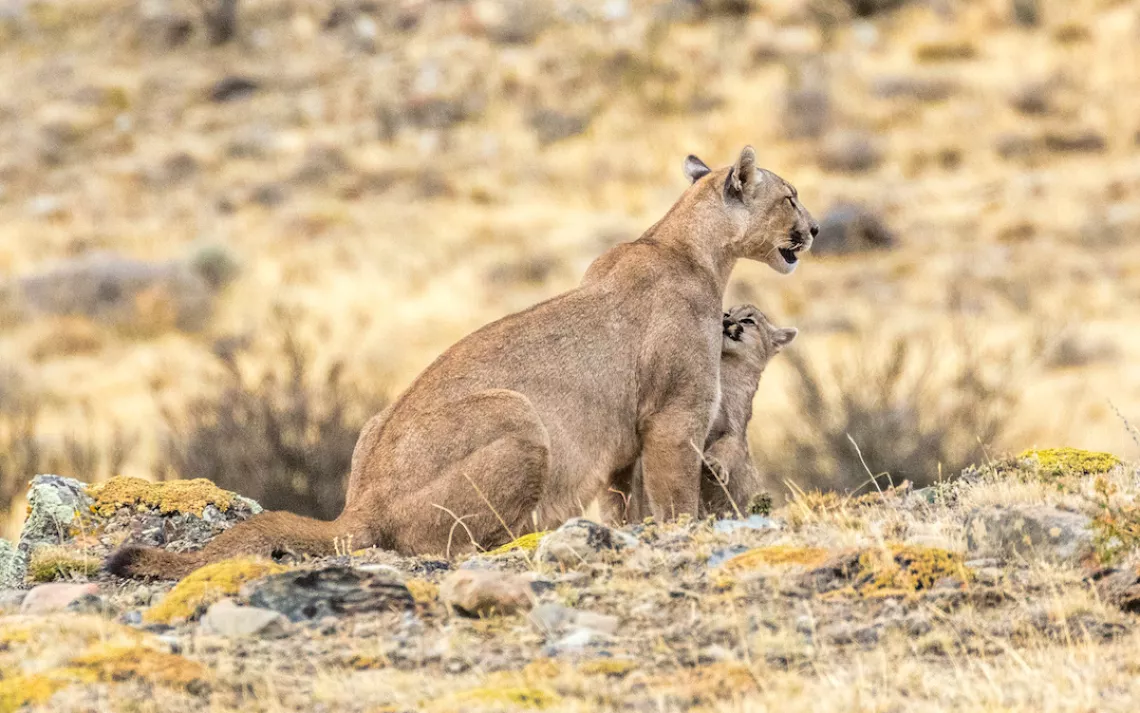The Puma Population in Patagonia Is Booming. Now What?
Pumas are thriving in southern Chile, increasing the risk of conflict with humans

Photos by Eric Mohl
The puma family was dining just inches off a paved road to southern Chile’s Torres del Paine National Park. It was a scene straight from a wildlife documentary: Alongside her young cubs, an adult female named Petaca gnawed on the carcass of a guanaco, a member of the camelid family that’s the Patagonian puma’s prey of choice. Less picturesque were the vehicles zooming past, or pulling over to join the growing crowd of people watching and photographing the pumas. Temporarily sated from their meal, Petaca’s cubs wandered, perilously, onto the road.
Those young cats summed up the joys and perils of being a puma in this part of Patagonia right now, where the puma population in and around Torres del Paine has been rebounding for at least a decade. Precise numbers are scarce—the first comprehensive scientific puma survey in many years is currently being interpreted by Panthera, a global wild cat conservation organization—but everyone I talked to, including locals, guides, and national park officials, reported seeing more pumas now than they used to.
One puma tracker told me she saw maybe a single puma per year before 2012. Over the course of a few weeks of reporting in and around Torres del Paine in March and April, I spotted 22 cats.
Conservationists attribute the rebound to a healthy population of guanaco, along with a reduction in puma hunting. When the pandemic came along, it offered the cats an unexpected boost; COVID-19 shut down tourism and closed the park for more than eight months, giving the cats and their prey even more room to flourish.
But it’s not just the number of pumas that has made puma sightings so much more common in and around this park. Torres del Paine is the second most-visited park in Chile, routinely attracting hundreds of thousands of visitors per year before the pandemic (more than 304,000 tourists came in 2019). Over time, many pumas around Torres del Paine have become habituated to humans and their vehicles. Now that the park has reopened to tourism, more pumas are being seen by more humans here than ever before.
Such puma-human encounters can be dangerous for both species. “People in the park see pumas acting like house cats,” adds Nicolas Lagos, a puma program conservation scientist at Panthera. “But that’s a predator that can kill you.” Guests at one local luxury lodge found a puma on their patio. Some guides at another lodge no longer jog alone between the guest area and staff housing for fear of triggering a puma’s natural chase instinct. Most striking, a child visitor in Torres del Paine was stalked by a puma on the Aonikenk Trail, an easy-going path that leads to culturally significant cave paintings. “Fortunately, the situation did not end in misfortune, but it was very close,” remembers Gonzalo Cisternas Lopez, ranger technical coordinator for Torres del Paine National Park, where he’s worked since 2000.

Photo by Eric Mohl
Puma attacks on humans are rare worldwide, and most encounters aren’t fatal. But after the stalking incident, Cisternas noted, the park added a requirement that hikers on the Aonikenk Trail be accompanied by a guide. And, film crews must now have pepper spray on hand when filming inside the park. Many guides and conservationists I spoke to fear that park traffic will eventually kill a puma on the road. But the most acute threat to these pumas might be sheep; or, rather, the humans who earn a living protecting those sheep.
This region of southern Chile is home to enormous sheep ranches, called estancias, where pumas have been killed as a threat to livestock for centuries. The park itself is a vast patchwork of former estancias and is surrounded by working sheep ranches. The greatest danger is for adult pumas seeking their own territories, because they sometimes move out of places where the big cats are protected and onto working estancias whose gauchos shoot pumas on sight.
“Some ranchers refer to human-habituated park pumas as ‘stupid pumas’ because they’re so easy to kill,” says puma tracker Miguel Fuentealba. Chilean law prohibits killing pumas, and the law is enforced inside the national park, but according to Lagos, “outside the park no one enforces that.” In his 2022 book, On the Edge: Puma, Torres del Paine, Lagos reports that a skilled puma hunter—called a leonero—working on a sheep ranch may kill 75 to 100 pumas a year, earning $200 to $400 per kill. “Humans are the only puma predator here,” he says.
As pumas become more plentiful and habituated to humans, puma hunting on estancias around the national park will become an even more significant threat. In recent years, however, a few of the park’s neighboring ranchers have adopted puma-friendly measures on vast tracts of land, thus expanding puma protection well beyond park boundaries.
Pia Vergara, creator and executive director of the not-for-profit Cerro Guido Conservation Foundation (where Lagos serves as a conservation advisor), is dedicated to finding ways for ranchers, sheep, and pumas to coexist. But it’s slow work getting gauchos to break centuries-old habits. So far, Vergara has convinced just two of the gauchos that work on Estancia Cerro Guido to go into the field with her to experience pumas in a different way.
“I would like to spend all of my time in the mountains, but I have to be the mediator between pumas and people,” says Lagos, who describes the work of the Cerro Guido Conservation Foundation as a combination of conservation and sociology. Ultimately, profit drives the puma killing in this region; ranchers estimate that every sheep killed is a loss of US$100.
With that in mind, the Cerro Guido Conservation Foundation is experimenting with unconventional methods of preserving profits without killing pumas. Today, 20 Great Pyrenees and Maremma dogs (breeds used in Europe to fend off wolf attacks) bark and scent mark to deter puma predation of the 18,000 sheep on Estancia Cerro Guido’s 250,000 acres. Mobile lighting is also being tested on the estancia. Numbers from 2020, the first year that these systems were in place, show puma predation of sheep on Estancia Cerro Guido hovered around 1 percent of the total number of animals on the land—a meaningful reduction in losses from the average puma predation rate of 7 to 10 percent.
The owners of Estancia Laguna Amarga adopted a different approach. After large numbers of their sheep perished in a snow and wind storm followed by a fire on their 17,000-acre third-generation family ranch, sisters Dania and Daneska Goic pivoted to tourism. They did not replace the sheep and, in 2015, identified 70 individual pumas on their estancia, which abuts the national park. In 2017, the former sheep ranch began offering guided puma-spotting tours. Laguna Amarga’s bottom line now also benefits from the production companies that want to shoot wildlife documentaries on the estancia. During a recent BBC shoot on Estancia Laguna Amarga, for the Dynasties series hosted by David Attenborough, crew members were astonished by the density and approachability of the pumas.
“I never thought this place would be so famous,” Dania says, adding that she and Daneska faced skepticism and open derision from owners of neighboring estancias when they began puma tourism, which makes their current success even sweeter. In 2022, the nearby Estancia Cerro Guido, which has a boutique hotel and restaurant, also began puma tourism, offering guests the chance to check camera traps and learn about pumas with specialist guides. Puma tourism is booming, from photography-focused tours to Quasar Expeditions’ multiday puma safari with a puma tracker and puma guide.
But as puma tourism options increase, the sector remains totally unregulated. The national park requires guides working within park boundaries to be highly trained and officially certified. Outside the park, anyone can call themselves a puma guide or a puma tracker (although some are certified national park guides). The closest thing to a puma tourism governing body are the social media groups used by those working in puma tourism, and an informal annual meeting during which the 20 to 40 people now working as puma trackers and puma guides talk about problems and best practices.
And even as puma tourism encourages change on some estancias, the potential for profit remains unevenly distributed. Estancias far from the park and its tourist revenues have little financial reason to evolve. Some insiders have suggested that puma tourism estancias near the park could share profits with more remote ranches, if they agree to forego killing the cats.
Until then, the vast majority of estancias in the Torres del Paine area are still doing things the old-fashioned way—relying on armed gauchos who view the pumas as nothing more than a costly threat to livestock. But Lagos is hopeful that coexistence measures and farm-based puma tourism are steps in the right direction. “People are proud of gaucho culture, and rightly so,” he says, “but pumas could inspire pride too.”
 The Magazine of The Sierra Club
The Magazine of The Sierra Club



